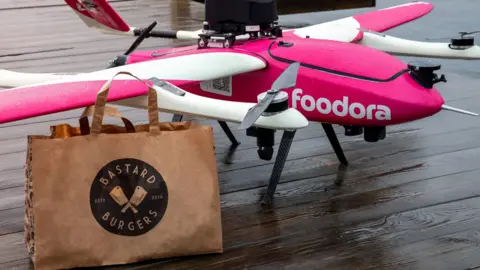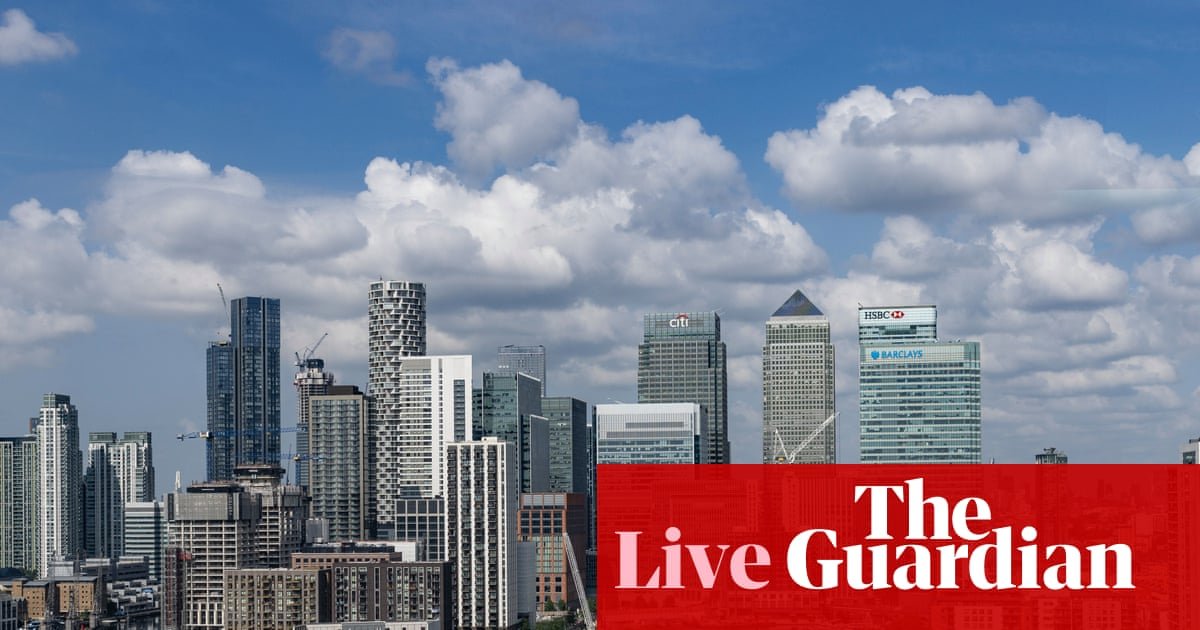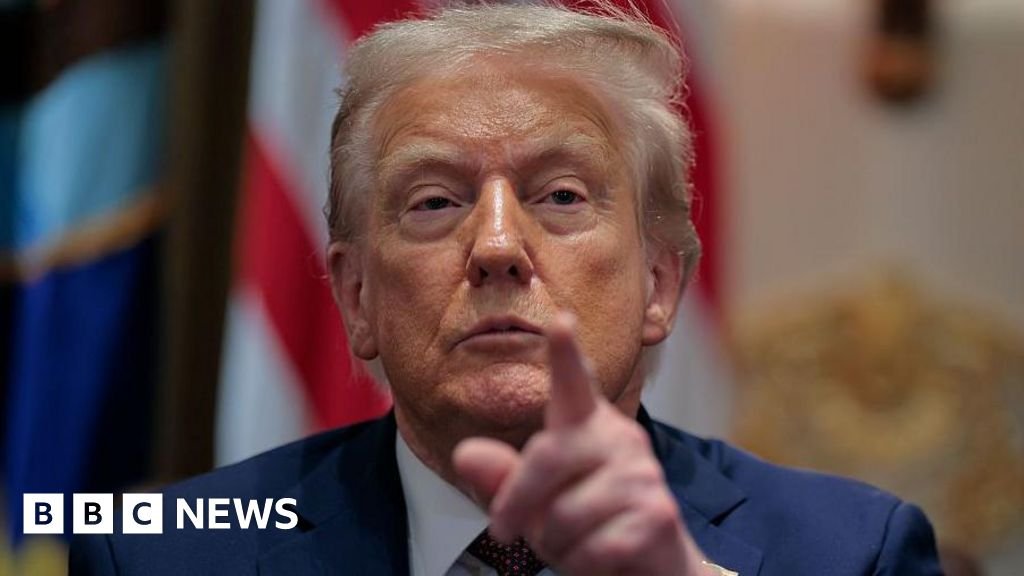Business
Will drones deliver your next hot food order?

MaryLou CostaTechnology Reporter
 Aviant
AviantMeal delivery is a luxury city dwellers take for granted – but more options are opening up for non-urban residents.
Boasting nearly 700,000 islands collectively, Sweden, Norway and Finland are home to the most islands in the world, their coastlines dotted by archipelagos that have shaped their history and culture.
While a number of the islands are accessible by ferry and bridge to residents of the region’s cities, there’s one thing locals are often missing: hot food delivery to their door, a service their city cousins probably take for granted.
But Norwegian start-up Aviant wants to change that, by establishing the region’s first food delivery service by drone – starting on the Swedish island of Värmdö.
Värmdö is just eight miles (13km) from Stockholm as the crow flies, and accessible by car, bus and ferry. But its population of around 46,000 – rising to up to 100,000 in the summer – has few hot food delivery options.
During a video call, Aviant co-founder and CEO, Lars Erik Fagernæs, shows me a map of the islands closest to Stockholm.
“All of the white and blue squares are where (delivery services) Foodora and Wolt have a service, and all of the black squares are where they don’t,” says Mr Fagernæs, who is based in the Norwegian city of Trondheim.
“As you can see on the map, there are 87,000 people who don’t have access to a home delivery service. These people live in what you would call suburbs, and would want to order takeaway food, but they just don’t have an option.”
Since February, though, residents of Gustavsberg, the main town on Värmdö, and surrounding areas, have been able to order freshly made burgers from Scandinavian chain Bastard Burgers directly to their door via drone, using Aviant’s technology.
The cost of delivery is comparable to that of a car or bike service, as drones take out the cost of the driver.
At the moment Aviant is in a “beta phase” – only delivering 10 items a week, while they check everything works.
But the plan is to scale up as the year goes on.
 Aviant
AviantAviant is also set to launch a similar service on the Norwegian peninsula of Nesodden – just four miles in distance from Oslo, but a 29-mile road journey. Mr Fagernæs demonstrates once again on a map.
“All the white is where you don’t currently have a food delivery service. So it’s about 100,000 people that’s going to now have access to home delivery that didn’t have it before,” he says.
It hasn’t been a straightforward process to perfect, Mr Fagernæs admits, as several trials were needed to ensure the food stayed hot and fresh during the maximum flight time of up to 10 minutes, over a radius of up to six miles.
“We have been testing this for three years, and in the beginning, there were a lot of soggy fries,” he recalls. “But we have improved the isolated container the burger goes in, and now we know it arrives warm, even in the winter months.
“People go crazy for it. They call their neighbors and their grandma. They think it’s like a UFO delivering their food.”
Mr Fagernæs hopes the two pilot services will provide the “recipe”, as he describes it, to embark on a full-scale rollout across Scandinavia, where many communities like those on Värmdö and Nessoden are beholden to their geography. He points back to the map.
“We don’t have huge cities, but these areas are viable for drone delivery, where they are on the border of urban with rural, which is very hard to serve by car, and that is a lot of the population in Scandinavia,” says Mr Fagernæs.
Aviant has identified around 40 bases across Scandinavia to expand to over the next two years, and sees similar geography in Canada, which has over 52,000 islands, and the north eastern region of the US, characterised by lakes, mountains and islands.
And what about the weather. Mr Fagernæs admits high winds will ground the drones occasionally, but expects the service to have 90% uptime.
 Getty Images
Getty ImagesAs for flying drones to deliver food into really remote areas, Aviant is one of a number of drone firms to have tested the waters, but found the numbers did not add up.
Starting in 2022, Aviant delivered Thai, Italian and sushi to residents outside of Trondheim. But that service was ended in August 2023.
Meanwhile, in 2022, UK firm Skyports delivered school meals to children in the Orkney islands, funded by Argyll and Bute Council, and temporarily ran a “fish and chip Fridays” delivery service to the wider community.
Similarly, German firm Wingcopter delivered everyday goods to rural residents in 2023 as part of a government partnership. In China’s eastern Zhejiang province, a local council is funding drone delivery of hot meals to elderly villagers isolated in the mountains.
But continuing these services without a government or corporate sponsor is not commercially viable.
Given the distances, the cost of delivery would be prohibitive for the person ordering, and too much for the outlet providing the food to waive. And, being rural areas, there aren’t enough locals to generate sufficient orders to begin with.
 Skyports/Royal Mail
Skyports/Royal MailSkyports has, however, been running a drone delivery service with Royal Mail across the Orkneys since 2023, and is looking at how the drones used in that can be repurposed to resurrect the hot meal delivery service, this time for all residents.
“We haven’t yet opened it up to other non-Royal Mail users as it’s currently strictly a Royal Mail service. But absolutely, we can be looking at when those drones aren’t in use, how we could be taking cargo from outlets on the mainland to the islands.
We would have to look at what the premium charged would be, as it will be important to lower the cost. Today we’ve just been focusing on getting the service right before we look at that expansion,” explains Alex Brown, Skyports director.
“You could absolutely make something like that work. The more you could utilise the drone, the better.
“So there are models where you have an anchor customer who’s underwriting that core cost, then you can incrementally bolt on new commercial opportunities to bring in additional revenue, and then a new service for people using it.”
Apart from making the finances stack up, in the UK, commercial drone operators must work closely with the Civil Aviation Authority to designate a segregated air space they can operate in, to avoid collisions with other aircraft, and minimise the risk of a crash to people on the ground.
While this prioritises safety, it makes the UK drone market far more difficult to enter than in Europe, Asia, or Australia, as Skyports’ Mr Brown notes.
Rural operators can, as he explains, make the case that they are operating in atypical air space, or space that isn’t likely to have other aircraft flying in it or many people below, as well as demonstrate that they’re using high tech navigation and hazard detection technology – options Mr Brown says the UK government is becoming increasingly open to, and is encouraging for entrepreneurs in the sector.
“It is getting easier, and to give the UK government credit, they are making good progress,” he says.
Business
UK long-term borrowing costs on brink of 27-year high; gold price hits record – business live | Business

Key events
Traders have also been piling into silver, driving it over $40 per ounce for the first time since 2011.
KCM Trade’s chief market analyst, Tim Waterer, says:
“Silver is making a move higher in response to expectations of lower U.S. rates, while a tight supply market is helping to maintain an upward bias.”
Gold hits record high over $3,500/oz
The gold has hit a new alltime high, as traders turn to precious metals as a safe-haven asset in inflationary times.
While government bond prices are falling (driving up yields), the spot price of gold has climbed over the $3,500 mark to hit $3,508.50 an ounce early this morning, with investors flocking to this traditional safe-haven asset.
The rally comes as the markets anticipate interest rate cuts in the US later this year, which has weakened the dollar.
Traders have been piling into gold-focused exchange traded funds (ETFs), which lifts demand for the precious metals, while some central banks have been adding to their own holdings.
Worries about inflation have also lifted demand for gold, as Tony Sycamore, IG analyst, explains:
This week’s rally in gold and silver began mid-morning yesterday and coincided with a social media post by US President Trump who claimed that prices in the USA are “WAY DOWN” with virtually no inflation.
However, this narrative contrasts with recent economic data showing persistent inflationary pressures remain and comes as President Trump continues his dovish reshaping of the Fed Board as he pushes for sooner and deeper Fed interest rate cuts, into an economy which is growing at ~3.5% in Q3 according to the latest Atlanta Fed GDP Now reading
UK long-term borrowing costs on brink of 27-year high
Good morning, and welcome to our rolling coverage of business, the financial markets and the world economy.
The bond vigilantes are back, piling pressure on governments in London and Paris amid fears over fiscal sustainability.
The UK’s long-term cost of borrowing is on the verge of hitting its highest level since 1998. Yesterday the yield, or interest rate, on Britain’s 30-year debt rose as high as 5.646%, just a whisker from the 27-year high of 5.649% set during trading on 9th April.
That pushes up the cost of adding to Britain’s national debt, eating into the headroom available to chancellor Rachel Reeves as she draws up the autumn budget.
Bond vigilantes punish governments for what they consider to be bad policy choices, by shunning debt auctions or by demanding higher and higher rates of return before buying government bonds.
Fiscal concerns have been pushing up long-term borrowing costs globally in recent weeks; September is traditionally a tough month for the bond markets, so the next few weeks could be volatile.
UK debt is in the firing line due to fears that the economy will slow later this year, and that Reeves faces a budget black hole that will need to be filled through either tax rises or spending cuts.
As Deutsche Bank’s chief UK economist, Sanjay Raja, told clients:
At the risk of sounding a little dramatic, the Autumn Budget will be a defining moment for the UK. On our estimates, a fiscal hole worth GBP 20-25bn will need to be filled in November.
Kathleen Brooks of XTB says August was “dreadful” for UK bonds, explaining:
This summer’s drip feed of potential tax rises has not gone over well with voters, and Labour has been hemorrhaging support to Reform in recent weeks. Essentially voters don’t want tax rises, while Labour backbenchers don’t want spending cuts, but something will have to give.
Political turmoil in Paris has pushed France’s bond yields higher in recent weeks too, widening the gap with Germany. The French government could fall next week, if it loses a confidence vote called over unpopular spending cuts.
French 30-year bond yields hit a multi-year high of nearly 4.5% yesterday.
France’s 30-year government bond yield is now the highest since 2008 (green). We’re in a new world. COVID landed us with a global debt overhang. There’s no room for big deficits now, because markets’ appetite for more debt is low. The right response is to reform. Not cap yields. pic.twitter.com/jzYuD4evLy
— Robin Brooks (@robin_j_brooks) September 1, 2025
ING fear French bonds could continue to be pummelled by political uncertainty, telling clients:
The spread between French government bonds (OATs) and the German equivalent (Bunds) widened materially on the prospect of a confidence vote, and we still see the balance of risk tilted to further widening. The current 10Y spread is at a similar level to that seen in July 2024, when French President Emmanuel Macron called snap elections and OATs sold off significantly in response.
The agenda
Business
Trump says India offered to remove tariffs on US goods

US President Donald Trump says India has offered to cut its tariffs “to nothing” even as he called the current trade stalemate with the country “a totally one sided disaster”.
US tariffs of 50% on goods from India – which includes 25% penalty for Delhi’s refusal to stop buying oil from Russia – took effect last week.
India has not responded to Trump’s latest comment but such war of words over Russian oil has caused Delhi-Washington ties to hit an all-time low.
Trump’s comment coincides with Indian Prime Minister Narendra Modi attending the Shanghai Co-operation Organisation (SCO) summit in Tianjin where he met Chinese President Xi Jinping and Russian President Vladimir Putin.
Washington says Delhi has been indirectly funding Russia’s war in Ukraine.
“India buys most of its oil and military products from Russia, very little from the US,” Trump wrote, adding Delhi should have cut tariffs “years ago”.
Delhi has previously said that oil supply from Russia was vital to meet the energy needs of its vast population.
It has also called the tariffs “unfair, unjustified and unreasonable”.
Last week, the country’s commerce minister, Piyush Goyal, said India “will neither bow down nor ever appear weak” in its economic relationships with other countries.
He also said the country was ready to a have a free-trade agreement with anyone who wanted it.
On Monday, Trump wrote: “What few people understand is that we do very little business with India, but they do a tremendous amount of business with us. In other words, they sell us massive amounts of goods, their biggest “client,” but we sell them very little – Until now a totally one sided relationship, and it has been for many decades.”
The US was, until recently, India’s largest trading partner and the tariffs have sparked fears that exports and growth in the world’s fifth largest economy could suffer.
At the SCO summit, Modi was seen shaking hands with Putin ahead of a meeting hosted by Xi.
The SCO, whose members include China, India, Iran, Pakistan and Russia, is seen as a challenge to Trump and US dominance on a global level.
Putin and Modi later spent 45 minutes inside the Russian leader’s car – after which Modi posted a picture of their journey alongside the compliment to Putin.
The Indian PM said he had an “insightful” exchange with Putin.
Business
Blame migrants, or blame the rich? That’s the populist divide in Britain’s politics now | Gaby Hinsliff

The long, hot summer of discontent is finally over. Parliament returned this week if not exactly with a rush of back to school energy, then at least with the sense that the government is now back to fill what was becoming an increasingly dangerous August vacuum.
When exhausted ministers retreated to lick their wounds over the summer, Nigel Farage saw his chance and took it, filling the slow news days with encouragement of protesters over asylum seeker accommodation. He was rewarded by polling showing voters now see immigration – the terrain on which Reform UK is palpably desperate to fight an election, because it’s terrain on which Labour can never go far enough to please some supporters without horrifying half the rest – and not a broken economy as Britain’s biggest problem, an impression arguably only reinforced when the government’s first announcement on returning from recess was a crackdown on refugees bringing their families to Britain.
Yet its second move, more hearteningly, was a reshuffle of economic policymaking that suggests Reform isn’t necessarily guaranteed to have everything its way this autumn. Having hired the former deputy governor of the Bank of England Minouche Shafik to advise him, Starmer has also now poached Rachel Reeves’s restless deputy Darren Jones to work for him on delivery. Both moves come ahead of an autumn budget marking what may be Labour’s last real chance to get out of its defensive crouch and move on to the attack.
Do you blame migrants and the politicians who let them in for Britain’s problems, or wealthy elites plus the politicians who let them get away with too much? It’s a depressing question for anyone seeking something more inspiring than a choice of scapegoats to hate, and also arguably a trick one, given neither is obviously to blame for a small country’s struggles with low productivity plus the cumulative blows of a banking crisis, austerity, Brexit, Covid, and several years of lousy government. But it’s shaping up to be the question of the autumn anyway, for a country pulled one way by surging rightwing populism and the other by a nascent leftwing version, springing up around the Green leadership contest and what may or may not turn out to be the second coming of Jeremy Corbyn.
A genuinely popular government could come straight through the middle, but an unpopular one risks being left for dead if its only answer to such a fundamental “whose side are you on?” question is to squeak that actually it’s more complicated than that. When forced to choose, research for the thinktank Persuasion found 44% of Britons blame the rich for our national woes compared with 38% who blame migrants, though with some important nuances. (The over-60s are twice as likely as gen Z to blame migrants, while graduates are angrier than non-graduates at wealthy elites, despite being statistically more likely to join them.) But while Reform UK voters are unsurprisingly heavily anti-migrant, Labour voters who would consider voting Reform – the ones who stalk Downing Street’s nightmares – are still more inclined to blame the rich for their troubles.
That may help explain why, when Persuasion ranked imaginary Labour policies earlier this year by how likely they were to keep Labour 2024 voters loyal, a wealth tax on the top 1% was the second strongest contender, boosting Labour at the expense of both the Greens and Reform. (Pledging to scrap human rights law and deport all asylum seekers, by contrast, actively helped the Greens recruit while cutting little ice with Reformers.) If immigration divides Labour’s big city liberal voters from their “red wall” cousins, the one thing on which they still agree is soaking the rich.
None of this makes a specific levy on the 1% an intrinsically brilliant idea, popular as it is with the 99% of us who wouldn’t pay it. Any income stream reliant on a tiny handful of highly mobile multimillionaires with excellent accountants is too precarious a basis for funding public services, and even if it worked, it would be nowhere near covering the future needs of a country facing various existential challenges. But the broader principles of taxing the wealthy – that in a national crisis those with more should contribute more, and that assets get off relatively lightly compared with income under the British tax system – is one whose time has come.
It’s still hugely risky territory for a chancellor with no electoral mandate for raising taxes, who promised after last year’s budget not to keep coming back for more. But a big fat political row over taxing the rich is arguably less dangerous for Labour now than getting trapped in the doom loop of arguing about immigration, and it would make life more uncomfortable for Reform, a party of the economically squeezed led by some very rich men.
Over summer, the Treasury has let speculation run wild about budget tax raids on everything from inheritance to pensions, property and rental income. Many of the kites flown will ultimately come crashing to the ground, but the overall message is that the once unthinkable can at least now be considered. Whitehall has noted the rising profile of the junior Treasury minister Torsten Bell, a well-networked former adviser to chancellor Alistair Darling, among others, and a creative thinker who argued for bold tax reforms in his recent book Great Britain? How We Get Our Future Back. (He also used to run the Resolution Foundation thinktank, which led an inquiry into the causes of economic stagnation chaired by Shafik; another Resolution employee turned MP, the economist Dan Tomlinson, joined the Treasury in Monday’s mini-reshuffle).
Last autumn’s painful budget measures were presented with much hand-wringing about how ministers really didn’t want to do this but had no choice, a strategy meant to pin blame on the last government which inadvertently left the new one sounding oddly unsure of itself. Listening to Bell arguing on air this August with LBC’s Tom Swarbrick about Reeves’s plans to extend inheritance tax to pension pots was a reminder of what confidence sounds like. Why shouldn’t he pass unused retirement savings on to his children after his death, Swarbrick asked? Nonsense, Bell scoffed: pensions are for supporting people in old age, not avoiding inheritance tax. Like many a Treasury aide turned not remotely humble MP, he isn’t universally beloved by colleagues, but Bell knows how to put up a fight – a skill that will be in demand this autumn. For a government this far behind in the polls, everything is now going to be a battle. What matters now, as all good generals know, is picking the most favourable terrain on which to fight.
-

 Business4 days ago
Business4 days agoThe Guardian view on Trump and the Fed: independence is no substitute for accountability | Editorial
-
Tools & Platforms3 weeks ago
Building Trust in Military AI Starts with Opening the Black Box – War on the Rocks
-

 Ethics & Policy1 month ago
Ethics & Policy1 month agoSDAIA Supports Saudi Arabia’s Leadership in Shaping Global AI Ethics, Policy, and Research – وكالة الأنباء السعودية
-

 Events & Conferences3 months ago
Events & Conferences3 months agoJourney to 1000 models: Scaling Instagram’s recommendation system
-

 Jobs & Careers2 months ago
Jobs & Careers2 months agoMumbai-based Perplexity Alternative Has 60k+ Users Without Funding
-

 Funding & Business2 months ago
Funding & Business2 months agoKayak and Expedia race to build AI travel agents that turn social posts into itineraries
-

 Education2 months ago
Education2 months agoVEX Robotics launches AI-powered classroom robotics system
-

 Podcasts & Talks2 months ago
Podcasts & Talks2 months agoHappy 4th of July! 🎆 Made with Veo 3 in Gemini
-

 Education2 months ago
Education2 months agoAERDF highlights the latest PreK-12 discoveries and inventions
-

 Mergers & Acquisitions2 months ago
Mergers & Acquisitions2 months agoDonald Trump suggests US government review subsidies to Elon Musk’s companies


